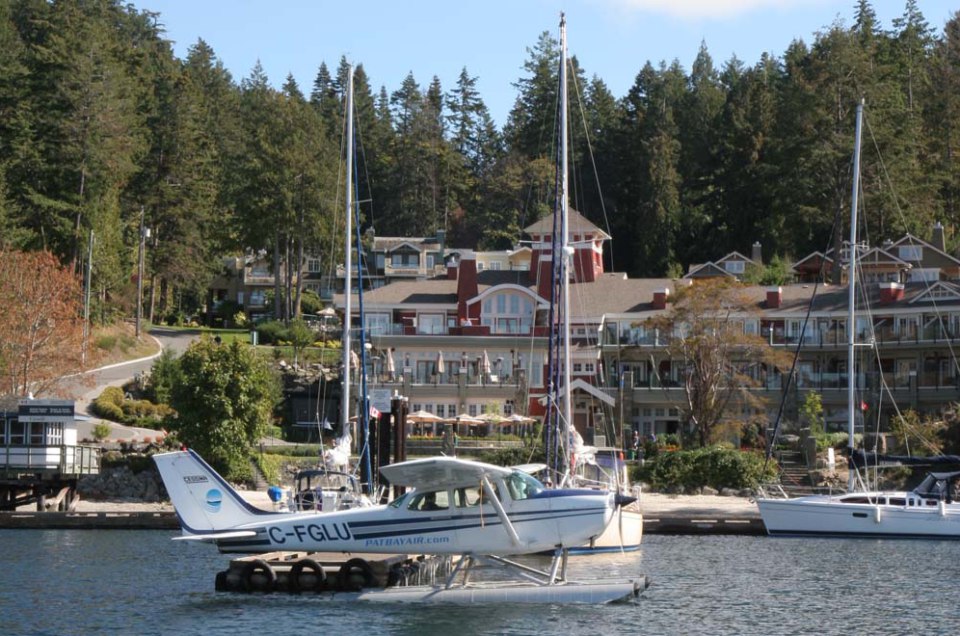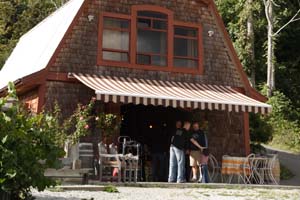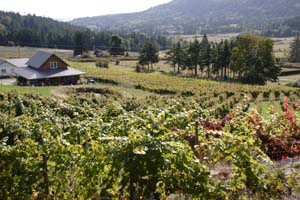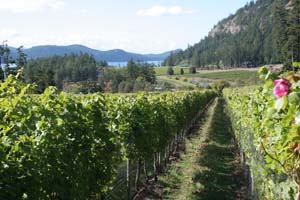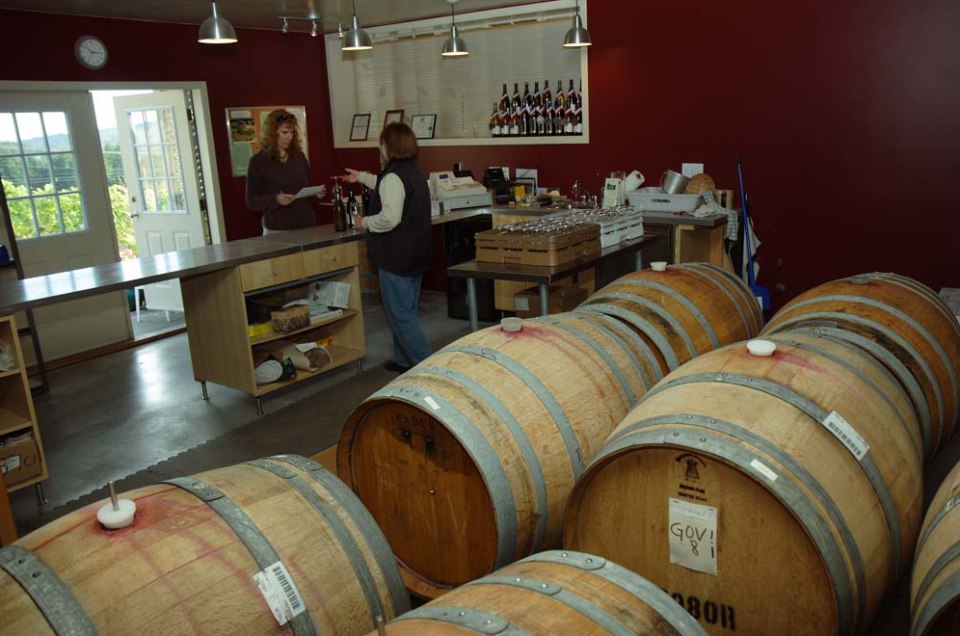We stepped out on deck just after the ferry sailed clear of the Tsawwassen terminal. Standing close together, braced against the wind, we admired the stars. Behind us, Vancouver’s lights faded and ahead of us, BC’s Gulf Islands were low shadows. After two hours, our ferry docked at Long Harbour on Salt Spring Island. A few minutes later we met the staff at the venerable Hastings House and we were shown our suite.
Warren Hastings built Hastings House in 1940, replicating his 11th century Sussex-style family home. “He was a yacht designer, like you,” I informed my slumbering yacht- designer husband as I watched the sunrise over Ganges Harbour the next morning. “They’ve left us a basket with yummy looking muffins. Would you like the raspberry one?” I asked, trying to wake him.
I munched on baked goods, poked my way through the room’s charming built-ins, played a couple of the CD’s by local musicians and looked out each of the windows several times – admiring the gardens and the view of the harbor. Finally I began to nibble at Evan’s muffin. “You’re going to miss out on the market and your muffin if you don’t wake up,” I said.
It’s a short five-minute walk from Hastings House to the Ganges Village Saturday market. The market gives shoppers access to a wide range of farmers and artisans who sell only what they can make, bake or grow – from hand-forged kitchen knives to French pastries.
Sampling and shopping my way from stall to stall, I was discovered I was remarking on the heady aroma of a tomato to a stranger when I realized I had lost Evan. So I made my way back past organic squash, heritage apples, homemade bread and preserves until I found him sampling David Wood’s goat cheese with truffles. “Perfect for a picnic,” the vendor pointed out.
While Evan chose bread to go with the cheese and talked organic peppers with Michael Ableman of Foxglove Farms, silversmith, Antony Marcano of Fresh Silver regaled me with the amusing stories that accompany his creative work. A silver relief map of Vancouver Island – my family’s home for many generations, caught my eye. “It’s completely accurate,” Marcano explained of the two-inch pendant. “You could navigate a boat by it.”
Picnic in hand; we set off for Ruckle Provincial Park. Overlooking Swanson channel, we ate lunch while watching a family of river otters play and fish. Despite the lovely setting, it was soon time to move on. There were studios and farms and, most importantly, Salt Spring and Garry Oaks Vineyards still to visit.
Grape growing is relatively new to the Gulf Islands. The first vines in the region were planted on Vancouver Island, in nearby Duncan, in the 1980’s; commercial sales didn’t really begin until the late 1990’s. The results have been pretty exciting though. Business is booming and the awards are sailing in. Currently there are seven wineries and over 100 acres planted to grapes on five Gulf Islands.
Salt Spring and Garry Oaks are just down the road from each other, but visiting the neighbors makes it clear just how truly individual the Gulf Island vineyards are. All the wineries are working with similar climatic conditions, grape varietals and watering restrictions (most use some method of rain fed irrigation ponds – not their scarce island water supply.) And all of them practice a combination of sustainable and organic methods. But none of the wineries produces a wine that tastes like any other.
We stopped in at Salt Spring Vineyards first. In the busy tasting room a group of tourists make their way through the wines. “The wines go well with food. They’re meant to be enjoyed,” the sales lady explained as she paired each wine with a local cheese.
A few of the wines, including the yummy apple pie made from organic Salt Spring apples, were already sold out (this was true at all of the vineyards, as production is not yet keeping pace with demand.) But the Millotage was available, a combination of Salt Spring grown Leon Millot and Marechal Foch, it carried a big fruity flavor. There was also a Pinot Blanc, made with grapes grown on Salt Spring and the Saanich Peninsula, it smelled of kiwi and had a delicate tropical flavor. I commented to Evan that if we had, had a bottle of this lovely wine on our picnic – we might still be watching the otters.
Outside the pretty tasting room, the vines, laden with ripening grapes, stretched down to the road. The ocean sparkled in the distance and a couple of Indian Runner ducks swam in the pond. I went for a wander through the fields hoping to run into the wine maker Paul Troop. Troop, who has been making wine for more than 30-years, says he enjoys experimenting with the grapes – trying to develop varietals that thrive in the coastal region. He says his goal, “isn’t to make a wine that tastes like it came from anywhere – but one that tastes only of Salt Spring.”
From the casual friendliness of Salt Spring Vineyards, we made our way to the elegant beauty of Garry Oaks Vineyards. Owners Elaine Kozak and Marcel Mercier do everything at the winery and Kozak left her culling work to walk us through the terraced vines. Stopping to admire the view of the old oaks and the ocean, Kozak explained how they chose the rootstock and grapes that would best flourish in the relatively cool climate, “Coastal grapes ripen less predictably than in other regions. We need to work with what we get. Sometimes we need to get creative.”
In the wine shop Kozak poured, while she explained how she and Mercier left the corporate world to start the winery. The Pinot Gris was first up. The dry white wine was light and fresh with hints of pear and citrus. The estate grown Pinot Noir – with a scent of cherries and a fruity, smoky finish, made me ask if it was really true that they were sold out. Kozak explained that the vineyard produces 1700 cases a year and between farm-gate sales and supplying regional restaurants, “everything goes.”
That evening, in Hastings House’s intimate dinning room, with the memory of the Garry Oak Pinots still lingering – I ordered the chef’s menu and paired it with a Garry Oak Pinot Gris. The Chef put together a delicious meal that seemed based on highlights from the Saturday market. A Bright Farm tomato and Moonstruck feta cheese salad started the meal, followed by oysters with shaved fennel and wild artic char with a Chanterelle mushroom risotto.
The next morning we caught the early ferry so we could tour two more vineyards, on two more islands – Pender and Saturna. Poet’s Cove Resort on Pender offers winery and gallery tours and visitors can take advantage of their expertise (and vehicle or boat) to get to several destinations.
Our first destination was Morning Bay Vineyards owned by Keith Watt and Barbara Reid. As we walked through the steeply terraced vineyards, Watt explained that he owned the land for quite a while before deciding to clear it for winesteading.
“I was looking across the sound at Saturna’s vineyard and thought, ‘why not?’” he explained.
The waterfront location does have its challenges, the grapes were less ripe than the ones on Salt Spring, but Watt says he believes the climate can work for him, “the long season leads to a low alcohol wine. It tends to be crisp and food friendly. And you can drink it all afternoon.”
In the dramatic tasting room, which can be rented for events, Reid poured and talked. She explained that they had worked with consulting wine maker Tilman Hainle, “his expertise lets us make the wines we like to drink.”
The Bianco was their first estate release. A blend of Schonberger, Gewürztraminer, Pinot Gris and Riesling, it’s light and crisp, and gently perfumed. The estate Gewurztraminer had a bright citrus flavor that would pair nicely with local seafood. Watt said one of their most popular wines is a rose called Chiaretto (he proved the point when a local stopped in to buy a bottle.) The Chiaretto is made from estate grown Pinot Noir and has a smooth, light, fruity flavor.
After finishing at Morning Bay, we headed to the dock at Poet’s Cove for a picturesque boat ride to Saturna Island. The tour takes visitors around South Pender and includes a ride out to visit a seal rookery, well as some up close views of eagles and herons.
Saturna Island Family Estate Winery is the oldest in the Gulf Islands. The 60 acres of vines are producing a sufficient quantity (and quality) of Pinot Gris, Chardonnay, Gewürztraminer, Pinot Noir, and Merlot grapes to fill the 12,000 cases of wine bottled annually.
Manager Michael Vautour walked us through the vines, lamenting over the year’s cool weather and his “discontented merlot.” Vautour said they worked with consulting winemaker, Daniel Lagna, formerly of Mission Hill, to get the most out of their unique microclimate, which is warmed by the sheer cliffs of south-facing Mount Warburton. As we walked, he pointed out a roaming herd of feral goats, saying, “it’s different here.”
Back in the tasting room, Vautour suggested ordering from the busy bistro before starting our tasting. With an extensive menu and exceptional view – the bistro is a favorite with locals and visiting boaters. I ordered a Mediterranean snack plate, then made my way through the wines. The Gewurztraminer, which I liked on a previous visit, was sold out. But the crisp Pinot Gris made a great choice for patio sipping. We also tried the two Chardonnays – the unoaked was creamy feeling and tasted of green apple, while the oaked version had a classic buttery finish.
After relaxing on the patio, admiring the view, rode we took the boat back to Poet’s Cove, arriving in early evening. Settling into our pretty cottage, we watched the light as it shifted and changed over the water. A little while later, I sorted through our wine purchases and decided the perfect hot tub wine was Morning Bay’s Bianco. Glass in hand, we watched the moon rise over the forest and toasted the pioneering wine makers who understood that the Gulf Islands could only be made better with their own wines.
